Yes, yet another FromSoft post. In my defense, Elden Ring, 2022’s action RPG release, and FromSoftware’s foremost foray into the open world game format is impossibly large, and has proven just as impossible to keep out of my head. Boss battles, with their big climactic set pieces and heightened sense of challenge have always been FromSoft’s bread and butter when it comes to their contemporary era of action games. It seems these games are constantly pushing the envelope of how grotesquely deadly these big baddies can be. The opening boss battles of Elden Ring are a strong showing, coming in with all the bombast, shock, and awe that I’ve come to expect, but I did notice something – a subtle shift in the design for the likes of Margit The Fell Omen and the first major ‘chapter boss’, so to speak, Godrick The Grafted. This new design direction seems to carry forward with the rest of the bosses of the game, so I really wanted to talk about it.

For those unfamiliar, combat in FromSoft RPGs generally can be broken down like this; The boss has a pool of attacks and moves from which they will select their action, reactive to the player character’s position relative to themselves. A dragon may swing its tail if the player is behind them, or breath fire if the player is standing at a distance, and such. In response, the player has a number of options including blocking with their shield, moving out of the way of the attack, or avoiding damage with the dodge roll maneuver, which gives the player a brief window of invincibility. The dodge roll is very very powerful, and potentially frees up a hand that would otherwise be occupied with a shield, so the player can two-hand a more powerful weapon, or offhand a second weapon. As such, the dodge roll is traditionally the player’s greatest tool of avoiding harm while they look for punishes, brief windows in which a boss cannot counterattack. These punishes happen when the end of a boss’s action animation precludes them from taking another action for a brief moment. The recoil of swinging a huge axe, for example.
Traditionally, FromSoft RPGs like Dark Souls and the like have a very powerful strategy when it comes to fighting bosses – getting behind them. Though even as far back as Demon’s Souls, many enemies were equipped with back-facing attacks meant to dissuade players from becoming too comfortable back there, the caveat was generally that these back-facing attacks were a lot more manageable than many of the front-facing ones, so circle strafing enemies remained a pretty dominant strategy in most situations, all the way up to Dark Souls 3, with some exceptions, but we’ll get to that.
When I first fought the major boss Godrick The Grafted I found myself failing and dying. A lot. To be expected of the infamously difficult FromSoft RPGs, right? Well sure, but Godrick is a very early game boss, so I had to rethink my approach. Surely the first major boss couldn’t be that difficult. Godrick’s fight is split into two phases, though both operate generally the same. He has a large pool of attack options, but I’ll mention some of the most common ones. First he has what I’ll call his basic attack combo, which he prefers to use on players that are standing medium-close to him, in front of him. It starts with a very slow axe swing to teach players to rely on their eyes for dodge cues, not just prediction, as aggressive predictions tend to result in early dodge rolls that are punished by such slow attacks. He’ll then follow up this axe swing with a series of swipes of his arms and axe, using a combo of variable length. If the player disengages, the combo stops at two attacks, but continues for up to four attacks if the player stays close.
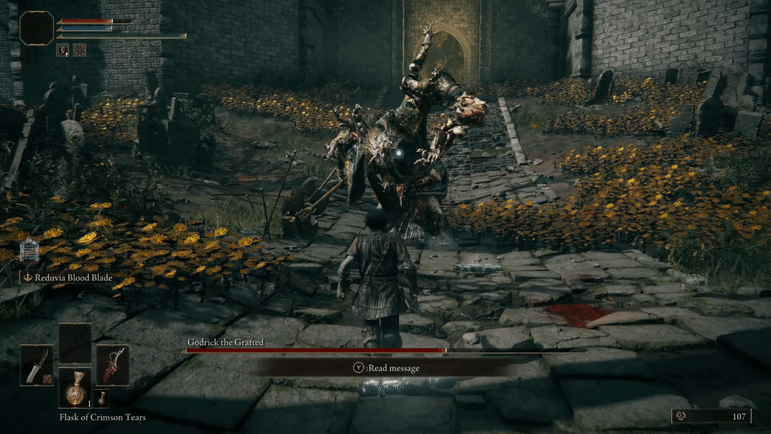
This attack presented a bit of a problem for my muscle memory. The dominant strategy of old in Dark Souls was to ‘dodge through’ enemy attacks. If you got the timing right, the invincibility of the dodge roll could carry you through the hitbox of an enemy sword swing, and the best way to do this would be to dodge into the arc of the swing, toward the direction it’s coming from. This minimizes the time your player character and the enemy hitbox intersect, making a successful dodge more likely. This results in a lot of getting behind enemies and proverbially hugging them up close. Try this on many of Godrick’s moves, however, and he’ll have a hasty response.
The better maneuver is to out-range Godrick, and dodge away from him as he attacks, dodging or moving toward him only to punish his openings, although these can be difficult to judge at first because he has so many followups. Remember how I said his basic attack has a variable length? Many many of Elden Ring‘s baddies have followups like that, contingencies to account for the different places the player might be standing to avoid harm, so sometimes what you think is a punishable opening on a boss is simply not.

Godrick’s ‘big swing’ attack, as I like to call it, happens when he rears up his axe with both hands slowly, giving the player ample time to reposition themselves in response. This attack has five very large swings, some of which hit in nearly 360 degrees. They’re also very deadly, making standing up close to him equally as deadly. This attack is very punishable, but only at the end of its run. Godrick has a lot of attacks like this, such has his whirlwind, which not only nudges players away in a circle around him with a bit of damage, but is immediately followed by one of two attacks that very difficult to distinguish without the full picture, and dodging the wrong one could mean taking a big hit. A lot of Godrick’s and many Elden Ring enemies’ moves are like this. They are of variable length, and potentially can sweep the player up in a very long combo. It’s not that getting behind a boss is impossible, it’s just not very safe.
Another feature worth mentioning, is the stagger system, somewhat borrowed from Sekiro. All enemies have an invisible value that is diminished when they take a hit, but constantly regenerates over time. If this value hits a certain minimum, the enemy will stagger, and become open to a critical attack. Due to its nature, and the many variables that go into it, this value can be somewhat unpredictable, especially as it is not displayed anywhere, unlike in Sekiro. Previous FromSoft RPGs had systems like this, though they were less powerful, only allowing an extra hit or two when enemies stagger, rather than a chance for big damage. Since the exact moment a boss will stagger is so unpredictable, the best thing to do is to just keep up the pressure, to increase your likelihood of getting a stagger, which naturally makes Elden Ring combat more aggressive and high-tension.
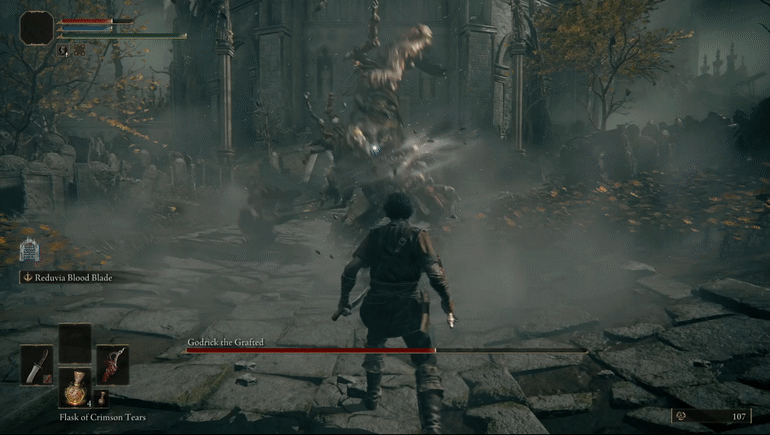
Frequently, if you do manage to get behind Godrick he’ll roll out of the way, and quickly prepare another attack. This often results in taking a hit, and disrupts your ability to consistently damage Godrick, meaning you’re less likely to stagger him with this route.
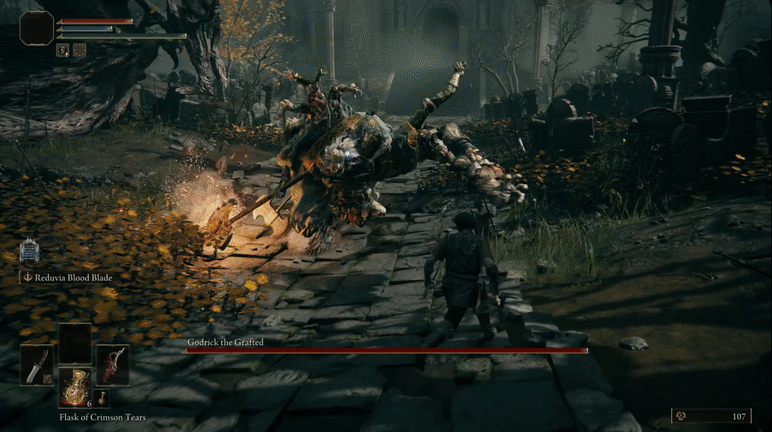
So what’s going on here? Why do the bosses in Elden Ring feel so different? I think I know. It seems to me that a major design goal for the bosses of Elden Ring ties into that verisimilitude I talked about when discussing Sekiro. FromSoft wanted fights in this game to feel more genuine, to reduce the friction between the gameplay and narrative of a life-and-death fight. In a real fight, you’d expect there to be a lot less dancing around opponents and a lot more squaring up, staring them down face-to-face, standing opposite one another as you trade blows. As such, everything about Godrick’s boss design makes him equipped to enforce that scenario. Getting behind him is dangerous, standing too close is dangerous, all defined by Godrick’s particularly designed behavior.
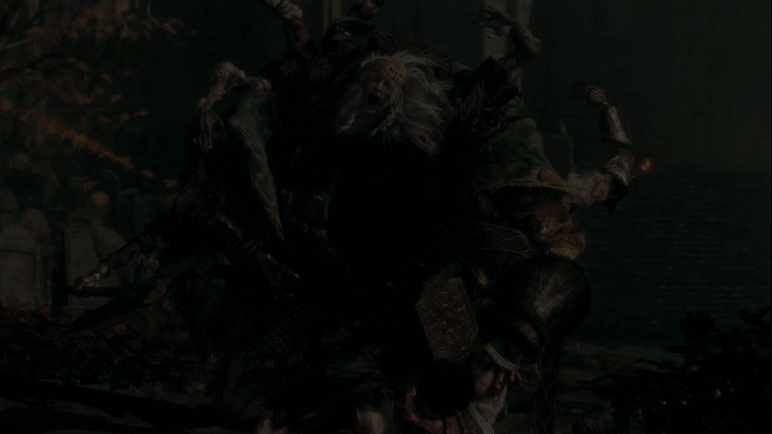
Between a much broader repertoire of tools at his disposal for hitting players at any angle, the ability to quickly reposition himself, and a much more unpredictable, variable moveset that adapts in length and reach to player positions in real-time, fighting Godrick the old way is much less viable. When players have to rethink their approach, they’ll likely come to a similar conclusion I did; the safest place to fight Godrick is in front of him, at a decent distance, where they can see his attacks clearly, and where dodging is less likely to be a death sentence. Compare Godrick to an early boss from the first Dark Souls game.
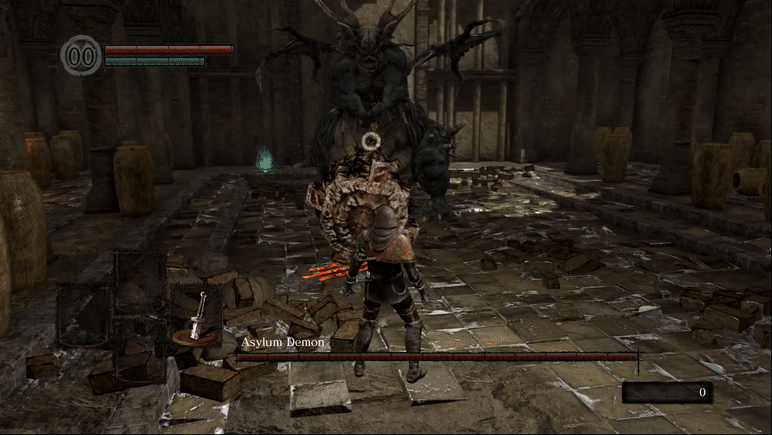
Notice how completely unable the asylum demon is to respond to my parking behind his rump. The Asylum demon does have an attack that can reach behind him, but it is exceptionally easy to dodge, with a huge slow windup. Also, it’s only just the one. Outside of trying to butt-stomp the player, the asylum demon really has no options. He can’t reposition himself either. Godrick, on the other hand, can… slam the ground to create a large earthquake in a circle around him, quickly whip up a whirlwing that knocks nearby players way, jump into the air to reposition himself and attack simultaneously, roll away to a more advantageous position, initiate his 5-hit super combo, etc.
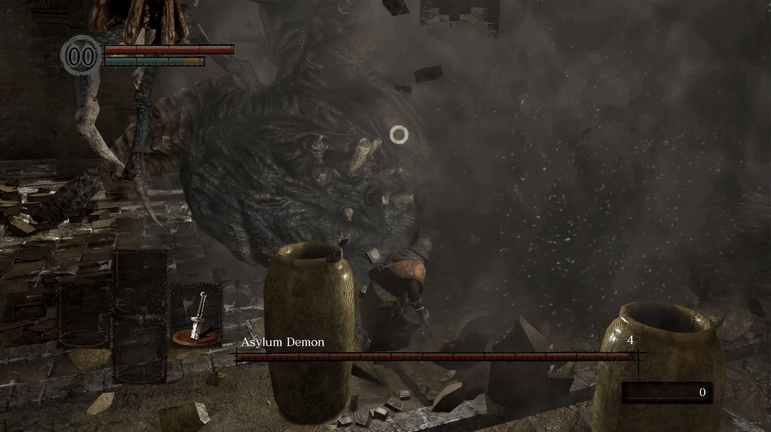
The old way of fighting bosses in Dark Souls was, and still is, fun. Some of the most fun I’ve had in a video game, but FromSoft isn’t a developer to rest on their laurels. The evolution of their boss design seems to be working more and more to create a believable experience with a strong sense of weight and presence. Verisimilitude is a major priority, but not only that, there are a lot of important advantages to designing bosses this way. For one, the player will be able to admire and appreciate the art of the boss they are fighting a lot more from a nice, framed, middle-distance shot, than from standing between their legs (depending on the boss, and the player, I guess..). The clearer framing also makes reading enemy telegraphs a lot clearer and easier. If a player is rightfully standing behind a boss because it’s the safest approach, camera zoomed up way close, they might understandably become frustrated by attacks they cannot see, and won’t determine the reason, succeeding by their strategy in the end, but having less fun in the process. Since so many of a boss’s attacks are triggered by the player position, having the player spend so much time in an awkward position may result in them not even seeing the boss’s coolest most impressive attacks, diminishing the entire set piece.
It seems FromSoft has been working toward this goal of the ‘squared off, face-to-face’ boss battle as a default for a long time. As far back as Dark Souls 2, we saw evidence of this. It is very popular to complain about the enemies’ ability in that game to track the player’s position with their attacks, meaning the enemy’s entire model actively rotates to align itself with player position, making circle strafing a weaker strategy. This worked to an extent, but also was pretty transparently artificial. People really just don’t move that way, spinning on their heel to align the swinging of their arms in a way that defied physics, so much so that my friends and I had taken to calling the process the ‘ballerina twirl’. Bloodborne reduced the ballerina twirling quite a bit, making up for it by giving the player a tool which made squaring up with bosses a lot safer – an extremely powerful frontal parry. Since the player needed their enemies to attack them from the front to succeed in a parry, it became a much more desirable spot to stand. The backstab of Bloodborne, being so slow, also meant circling around was suitable for stealth, but less suitable for active combat. Dark Souls 3 introduced a lot of the standard for how attacks are shaped in these games; big sweeping things that sometimes make as much as 360 degrees around the boss a danger zone. That game also introduced a lot of the adaptability and variability of enemy move-sets that made them more equipped to react to players constantly trying to get behind them.
This new design direction seems to have culminated in Sekiro, which was developed alongside Elden Ring. In Sekiro, parrying is everything, so enemies had to constantly be positioning themselves and the player into a squared off position. A lot of strategies employed to accomplish this seem to have carried over to Elden Ring, adapted to account for the lack of a strong parry, of course. The behavior of Sekiro‘s largest bosses is rather reminiscent of Elden Ring bosses. I can’t say I dislike this new direction FromSoft is taking its boss design. Godrick is a fun and exciting challenge, and one I actually got to see visually in its full glory! Just while recording footage for this post, I was struck by how consistently beautiful and exciting the action looked in motion, so by my estimation the efforts to make fights in Elden Ring feel more genuine, worked.
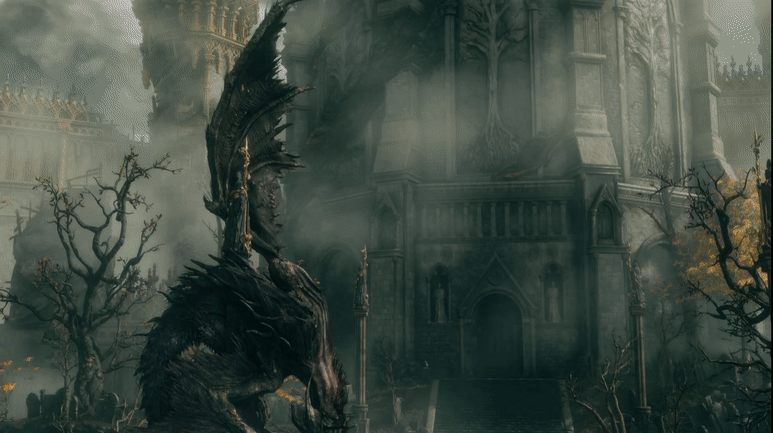
…And one day, we’ll return together …to our home, bathed in rays of gold…
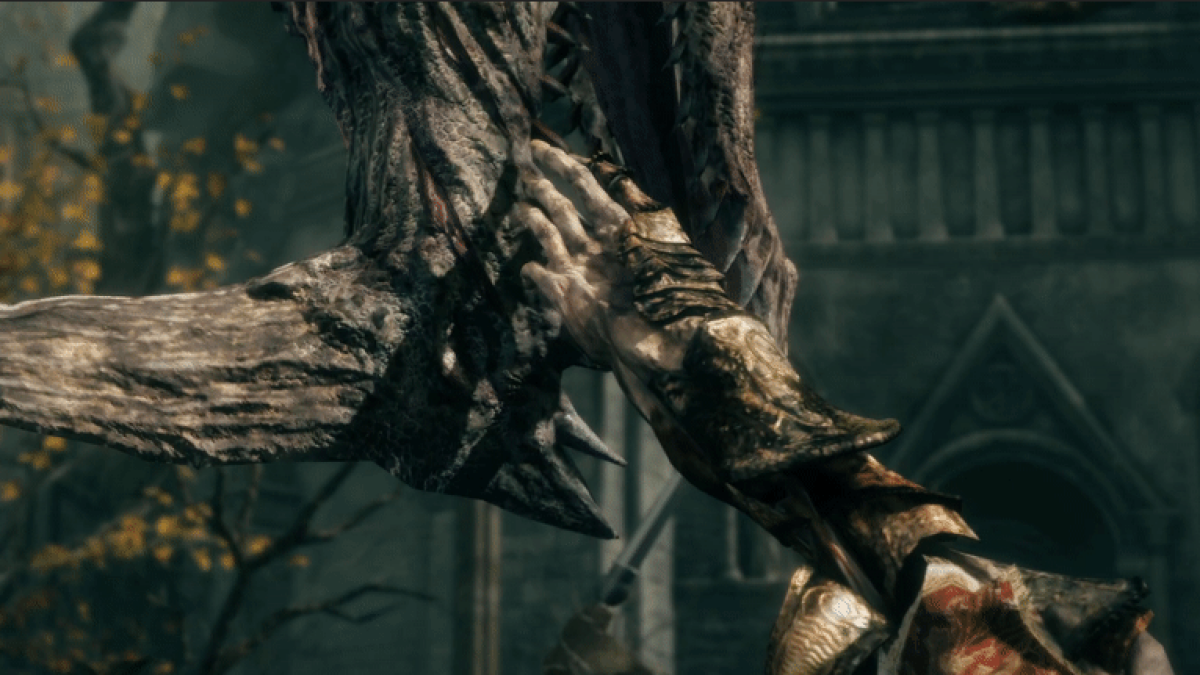
He was pretty hard for me when I first started too
LikeLike